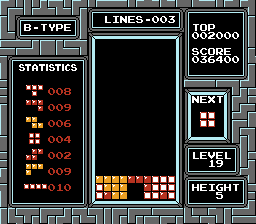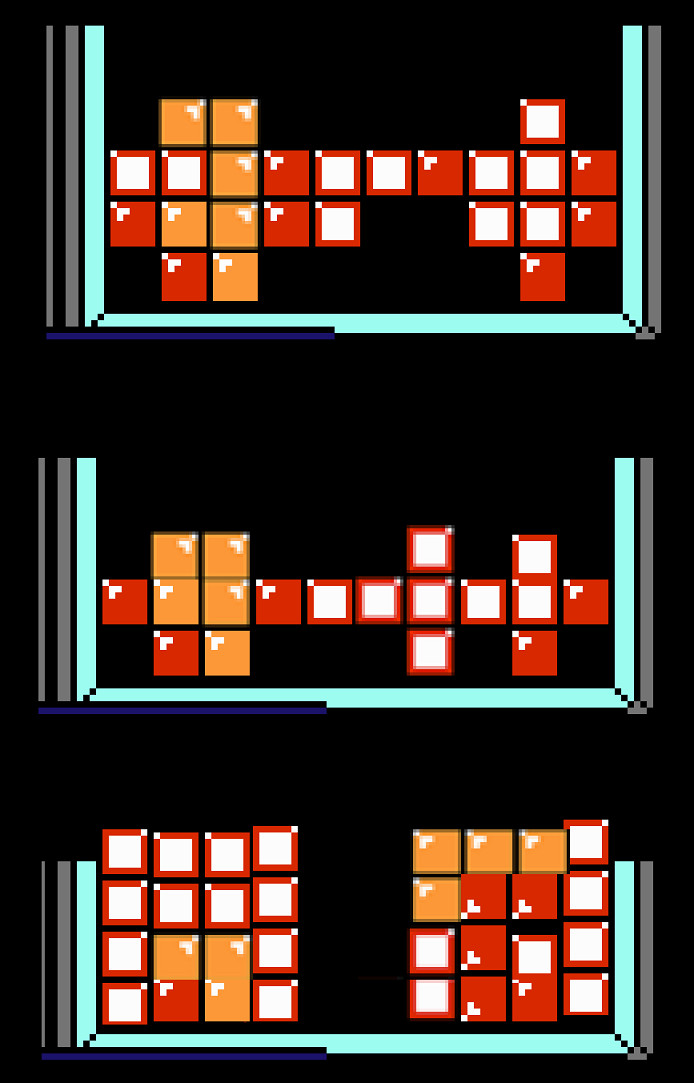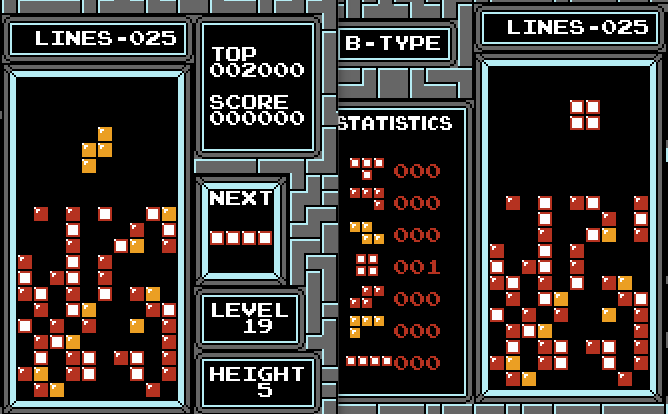
Someone was talking about TASing NES Tetris yesterday and I was accidentally prophetic...
The Mode B game's goal is to clear 25 lines. So, from a speedrun perspective, the fastest "Mode B" clear would be to just spam Tetrises near the top of the screen, same strategy as the 999999 points TAS. But from a stylistic perspective, clearing the board is obviously far superior, and with the hellish garbage the game gives you, makes it an extremely unique challenge compared to other Tetris TASes. So, for entertainment purposes, clearing the board is an important secondary goal.
An early input end is a fantastic way to save time in Tetris TASes without having to restart the entire thing. I love them because it takes special care to set up the board just right for the pieces to fall into place (literally).
As you said, it's possible that a faster run could be done using a different starting RNG (for a different garbage layout), but it's extremely hard to know for sure, and takes a LOT of effort to test each possibility. There could also be a much different build for this garbage layout, especially since this Tetris allows you to RNG manipulate what the next piece will be by delaying the current one. But considering Baxter's insane playaround TAS, it's safe to say he's quite good at building in Tetris.
One potential way a full rebuild could be faster is if it does more of its 13 non-garbage-clearing lines closer to the top, saving vertical piece travel. Another way is to minimize line clear animations, so less singles/doubles. But, the garbage is not placed in a way that makes either of these timesavers an obvious task, or even possible at all.
However, there seems to be one major timesaver that can apply to the exact same board build... It seems that soft drops are more interesting than you (or Baxter) may have thought. I wanted to figure out why, despite holding Down, the pieces were still moving at a rate of 1 row per 2 frames, yet sometimes, it would move down two frames in a row.
From what I can tell, after 3 frames of holding Down, the game will do a soft drop down one row, and reset the "frames until next drop" back to 2. This means if you hold Down, you may get one soft drop, but after that, no effect from holding Down, until you let go and hold the 3 frames again.
If this soft drop lines up with a gravity drop, it will only drop you one row that frame, so it has to be offset from the gravity drop. This leads to a pattern of 3 on, 2 off being the fastest I could find. Those 2 off frames are a great place to put horizontal movement without losing any time!

This does have the unfortunate result of completely desyncing all of the RNG manip. But I would guess that recreating the current build's piece order, but with optimized soft drops, would still save a LOT of time (relative to the length of the run, at least!).
There was also a 1 frame save I found on the final piece; you were moving the final piece left twice, then pausing to do one last manipulation. I moved the pause to in-between the two Left presses, allowing them to be done on two consecutive unpaused frames (a la SM64 pause BLJing). Saving a frame with a pause like this is probably only relevant for the final piece, since any other time, you're limited by the piece's vertical travel more so than its horizontal.
Anyway, as a proof of concept, I was able to save 24 frames by soft dropping and re-manipulating the final 4 pieces (it uses different post-input-end pieces as well):
http://tasvideos.org/userfiles/info/63491175011214274
Since the run is so short, resyncing with this new tech is definitely worth it. If you'd like to, go for it; if you'd rather not, I'm open to doing it. A collaboration could be helpful as well, if you'd like. The build is more key to the run than movement tech IMO, so I'd append myself onto the end authorship-wise.
I'm unsure if implementing this movement change without altering the pieces used would require a resubmission, or just an updated movie file.















 Someone was talking about TASing NES Tetris yesterday and I was accidentally prophetic...
The Mode B game's goal is to clear 25 lines. So, from a speedrun perspective, the fastest "Mode B" clear would be to just spam Tetrises near the top of the screen, same strategy as the 999999 points TAS. But from a stylistic perspective, clearing the board is obviously far superior, and with the hellish garbage the game gives you, makes it an extremely unique challenge compared to other Tetris TASes. So, for entertainment purposes, clearing the board is an important secondary goal.
An early input end is a fantastic way to save time in Tetris TASes without having to restart the entire thing. I love them because it takes special care to set up the board just right for the pieces to fall into place (literally).
As you said, it's possible that a faster run could be done using a different starting RNG (for a different garbage layout), but it's extremely hard to know for sure, and takes a LOT of effort to test each possibility. There could also be a much different build for this garbage layout, especially since this Tetris allows you to RNG manipulate what the next piece will be by delaying the current one. But considering Baxter's insane playaround TAS, it's safe to say he's quite good at building in Tetris.
One potential way a full rebuild could be faster is if it does more of its 13 non-garbage-clearing lines closer to the top, saving vertical piece travel. Another way is to minimize line clear animations, so less singles/doubles. But, the garbage is not placed in a way that makes either of these timesavers an obvious task, or even possible at all.
However, there seems to be one major timesaver that can apply to the exact same board build... It seems that soft drops are more interesting than you (or Baxter) may have thought. I wanted to figure out why, despite holding Down, the pieces were still moving at a rate of 1 row per 2 frames, yet sometimes, it would move down two frames in a row.
From what I can tell, after 3 frames of holding Down, the game will do a soft drop down one row, and reset the "frames until next drop" back to 2. This means if you hold Down, you may get one soft drop, but after that, no effect from holding Down, until you let go and hold the 3 frames again.
If this soft drop lines up with a gravity drop, it will only drop you one row that frame, so it has to be offset from the gravity drop. This leads to a pattern of 3 on, 2 off being the fastest I could find. Those 2 off frames are a great place to put horizontal movement without losing any time!
Someone was talking about TASing NES Tetris yesterday and I was accidentally prophetic...
The Mode B game's goal is to clear 25 lines. So, from a speedrun perspective, the fastest "Mode B" clear would be to just spam Tetrises near the top of the screen, same strategy as the 999999 points TAS. But from a stylistic perspective, clearing the board is obviously far superior, and with the hellish garbage the game gives you, makes it an extremely unique challenge compared to other Tetris TASes. So, for entertainment purposes, clearing the board is an important secondary goal.
An early input end is a fantastic way to save time in Tetris TASes without having to restart the entire thing. I love them because it takes special care to set up the board just right for the pieces to fall into place (literally).
As you said, it's possible that a faster run could be done using a different starting RNG (for a different garbage layout), but it's extremely hard to know for sure, and takes a LOT of effort to test each possibility. There could also be a much different build for this garbage layout, especially since this Tetris allows you to RNG manipulate what the next piece will be by delaying the current one. But considering Baxter's insane playaround TAS, it's safe to say he's quite good at building in Tetris.
One potential way a full rebuild could be faster is if it does more of its 13 non-garbage-clearing lines closer to the top, saving vertical piece travel. Another way is to minimize line clear animations, so less singles/doubles. But, the garbage is not placed in a way that makes either of these timesavers an obvious task, or even possible at all.
However, there seems to be one major timesaver that can apply to the exact same board build... It seems that soft drops are more interesting than you (or Baxter) may have thought. I wanted to figure out why, despite holding Down, the pieces were still moving at a rate of 1 row per 2 frames, yet sometimes, it would move down two frames in a row.
From what I can tell, after 3 frames of holding Down, the game will do a soft drop down one row, and reset the "frames until next drop" back to 2. This means if you hold Down, you may get one soft drop, but after that, no effect from holding Down, until you let go and hold the 3 frames again.
If this soft drop lines up with a gravity drop, it will only drop you one row that frame, so it has to be offset from the gravity drop. This leads to a pattern of 3 on, 2 off being the fastest I could find. Those 2 off frames are a great place to put horizontal movement without losing any time!
 This does have the unfortunate result of completely desyncing all of the RNG manip. But I would guess that recreating the current build's piece order, but with optimized soft drops, would still save a LOT of time (relative to the length of the run, at least!).
There was also a 1 frame save I found on the final piece; you were moving the final piece left twice, then pausing to do one last manipulation. I moved the pause to in-between the two Left presses, allowing them to be done on two consecutive unpaused frames (a la SM64 pause BLJing). Saving a frame with a pause like this is probably only relevant for the final piece, since any other time, you're limited by the piece's vertical travel more so than its horizontal.
Anyway, as a proof of concept, I was able to save 24 frames by soft dropping and re-manipulating the final 4 pieces (it uses different post-input-end pieces as well):
This does have the unfortunate result of completely desyncing all of the RNG manip. But I would guess that recreating the current build's piece order, but with optimized soft drops, would still save a LOT of time (relative to the length of the run, at least!).
There was also a 1 frame save I found on the final piece; you were moving the final piece left twice, then pausing to do one last manipulation. I moved the pause to in-between the two Left presses, allowing them to be done on two consecutive unpaused frames (a la SM64 pause BLJing). Saving a frame with a pause like this is probably only relevant for the final piece, since any other time, you're limited by the piece's vertical travel more so than its horizontal.
Anyway, as a proof of concept, I was able to save 24 frames by soft dropping and re-manipulating the final 4 pieces (it uses different post-input-end pieces as well):




 When you will resynced movie please also try to check this idea, perhaps with your new soft dropping technique you be able to find good RNG. One extra animation cost ~16-22 frames. So it worth to try eliminate it.
----
When you will resynced movie please also try to check this idea, perhaps with your new soft dropping technique you be able to find good RNG. One extra animation cost ~16-22 frames. So it worth to try eliminate it.
----

 It's off to a bad start right now, I'm matched up because of ending up RNG manipulating the same pieces Baxter did. But once the pieces aren't so close to the top, the soft dropping will save more frames, so I can hopefully use some new options then...
OK, I tried starting the run 1 frame sooner (which shifts ONE garbage block on the top row very slightly, as well as having different starting pieces) and built to the same shape, and am now 3 frames ahead! Hopefully more to come
It's off to a bad start right now, I'm matched up because of ending up RNG manipulating the same pieces Baxter did. But once the pieces aren't so close to the top, the soft dropping will save more frames, so I can hopefully use some new options then...
OK, I tried starting the run 1 frame sooner (which shifts ONE garbage block on the top row very slightly, as well as having different starting pieces) and built to the same shape, and am now 3 frames ahead! Hopefully more to come EDIT: Also, due to a 4-frame rule on line clear animations, this new layout didn't actually save any time at all! But I'm currently 28 frames ahead after the fourth triple.
Is there any chance we can do collaborating on a Discord server, rather than by email? It worked very well for the Dream Team Contest.
EDIT: Also, due to a 4-frame rule on line clear animations, this new layout didn't actually save any time at all! But I'm currently 28 frames ahead after the fourth triple.
Is there any chance we can do collaborating on a Discord server, rather than by email? It worked very well for the Dream Team Contest.

